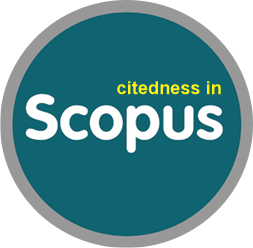The Influence of Job Characteristics, Placement, and Leadership Style on Employee Performance of the Ministry of Trade
DOI:
https://doi.org/10.32493/JJSDM.v6i1.24090Keywords:
Employee Performance, Job Characteristics, Placement, Leadership StyleAbstract
This study aims to determine whether job characteristics have a positive effect on employee performance, placement has a positive effect on employee performance, and leadership style has a positive effect on employee performance. This research was conducted at the Ministry of Trade of the Republic of Indonesia through a closed questionnaire with a total of 165 employees, using convenience sampling method and Partial Least Square – Structural Equation Modeling (PLS-SEM) analysis. The results showed that there was a positive and significant effect of job characteristics and leadership style on employee performance. Placement has a positive but not significant effect on employee performance. This research is expected to be input for organizations in an effort to improve employee performance through good management of job characteristics, placements, and leadership styles so that they can realize the goals of the organization.References
Agarwal, S. (2020). Leadership style and performance of employees. International Research Journal of Business Studies. 13(1), 1-14.DOI: 10.21632/irjbs
Aisyah, H. (2014). The effect of employee placement on performance in the regional revenue, financial and asset management department of Melawi Regency. Journal of S-1 Government Science. 3 (4).
Alfanny, J. (2018). Analysis of leadership style on performance (Case study employee of directorate of infrastructure investment development, Ministry of Public Works and Housing). Journal of Social Humanities. 11(1), 19-26. DOI: 10.12962/j24433527.v11i1.3695
Aryani, R. & Widodo. (2020). Exploring the effect of employability and job characteristics on contextual performance: Mediating by organizational commitment. Management Science Letters. 10, 2071-2076. DOI: 10.5267/j.msl.2020.2.004
Good, G. (2013). The effect of placement and experience on employee satisfaction and performance. Undergraduate thesis majoring in management at the Faculty of Economics and Business, Udayana University, Bali.
Coal, S. (2020). The influence of leadership style on employee performance in the procurement department of PT INALUM (Persero). Liabilities (Journal of Accounting Education). 3 (1). 40-58. DOI: 10.30596/liabilities.v3i1.4581
Evelyne, N., Kilika, J., & Muathe, S. M. A. (2018). Job characteristics and employee performance in private equity firms in Kenya. IOSR Journal of Business and Management. 20(1), 60-70. DOI: 10.9790/487X-2001026070
Fabio, B. P., Hubeis, M., & Puspitawati, H. (2016). The influence of leadership style, work motivation on organizational commitments that have implications for employee performance. Journal of Business and Management Applications. 2(1), 91-104.
DOI: 10.17358/JABM.2.1.91
Fatmah, D. (2017). The effect of job characteristics and employee competence on employee performance on CV. Fajar Mojokerto Printing. Ocean Journal of Economics and Business. 8 (2). 700-709. DOI: 10.33059/jseb.v8i2.428
Fatra, O. & Magdalena, M. (2020). The effect of career development, position placement and motivation on employee performance at the Kubung Sub-District Office. DOI: 10.31219/osf.io/ts94j
Ghozali, I. & Latan, H. (2015). Partial least squares: concepts, techniques and applications using smartpls 3.0 (2nd ed.). Semarang: Diponogoro University Press.
Hajati, D. I., Artiningsih, D. W., & Wahyuni, N. (2018). The influence of individual characteristics, job characteristics and organizational characteristics on employee performance (study at Kotabaru Polytechnic). Journal of Business and Development. 7 (1).
Jamaludin, A. (2017). The influence of leadership style on employee performance at PT Kaho Indahcitra Garment Jakarta. Journal of Applied Business and Economics. 3(3), 161-169. DOI: 10.30998/jabe.v3i3.1767
Junaidi, R. & Susanti, F. (2019). The influence of leadership style and organizational culture on employee performance at UPTD Baltekkomdik Education Office of West Sumatra Province. DOI: 10.31227/osf.io/bzq75
Kahya, E. (2007). The effects of job characteristics and working conditions on job performance. International Journal of Industrial Ergonomics. 37, 515 – 523.
Kock, N., & Hadaya, P. (2018). Minimum sample size estimation in PLS-SEM: The inverse square root and gamma-exponential methods. Information Systems Journal, 28(1), 227-261.
Lydia, C. (2014). Analysis of the effect of job characteristics on employee satisfaction and performance at Hotel D'season Surabaya.
Makambe, U & Moeng, G. J. M. (2019). The effects of leadership styles on employee: A case of selected commercial bank in Botswana. Annals of Management and Organization Research (AMOR). 1(1), 39-50. DOI: 10.35912/amor.v1i1.274
Mangkunegara, A. P. (2017). Company human resource management. Bandung: PT. Rosdakarya Youth.
Mendoza, M., Nasution, H., & Matondang, N. (2018). Influence of compensation, job characteristics and leadership style through motivation to employee performance. KnE Social Sciences. 587-600. DOI: 10.18502/kss.v3i10.3406
Montolalu, R., Kawet, L., Nelwan, O. (2016). The influence of personality, work orientation, and employee placement on work performance at The Department of Culture and Tourism of The Province of North Sulawesi. EMBA Journal. 4(1), 1318-1329.
Moses, R. M., Astuti, E. E., & Hakam, M. S. (2014). The influence of individual characteristics and job characteristics on employee performance. Journal of Business Administration (JAB). 12(1), 1 – 10.
Narottama, H. (2015). The effect of job characteristics and financial compensation on job satisfaction and employee performance. E-Journal of Unud Management. 4 (12), 4302 – 4334.
Ohemeng, F. L. K., Amoaks-Asiedu, E., & Darko, T. O. (2018). The relationship between leadership style and employee performance: An exploratory study of the Ghanaian public service. International Journal of Public Leadership. DOI: 10.1108/IJPL-06-2017-0025
Regulation of the Minister for Empowerment of State Apparatus and Bureaucratic Reform of the Republic of Indonesia Number 1 of 2020 concerning Guidelines for Position Analysis and Workload Analysis. Accessed from https://peraturan.bpk.go.id/Home/Details/143660/permen-pan-rb-no-1-tahun-2020.
Regulation of the Minister for Empowerment of State Apparatus and Bureaucratic Reform of the Republic of Indonesia Number 26 of 2020 concerning Guidelines for Evaluation of the Implementation of Bureaucratic Reform. Accessed from https://peraturan.bpk.go.id/Home/Details/143703/permen-pan-rb-no-26-tahun-2020.
Regulation of the Minister of Trade of the Republic of Indonesia Number 80 of 2020 concerning the Organization and Work Procedure of the Ministry of Trade. Accessed from http://jdih.kemendag.go.id.
Puspita, T. (2020). the effect of perceived job characteristics and organizational support on OCB by mediating employee normative and growth commitment. Infokam Journal. 16(1), 13 – 24.
Rahman, F., Rahmawati, E., & Utomo, S. (2020). The influence of individual characteristics, job characteristics, and organizational characteristics on the performance of contract employees (Study at FISIP ULM Banjarmasin). Journal of Business and Development. 9(1), 69 – 82.
Runtuwene, P., Tewal, B., & Mintardjo, C. (2016). Effect of job placement, mutation, and workload on employee performance at PT Bank Sulutgo Manado. Scientific Journal of Efficiency. 16 (1).
Sarwono, J. & Narimawati, U. (2015). Making thesis, thesis, and dissertation with partial least square sem (pls-sem). Yogyakarta: Andi.
Sen, C. & Dulara, S. (2017). Job characteristics and performance: The mediating role of job crafting. The International Journal of Indian Psychology. 5(1), 66-74. DOI: 10.25215/0501 068
Setiawan, A. & Pratama, S. (2019). The influence of leadership style, effective communication and decision making on employee performance at CV Bintang Anugerah Sejahtera. Journal of Management Tools, 11(1), 19-34.
Siagian, T. S. & Khair, H. (2018). The influence of leadership style and work environment on employee performance with job satisfaction as an intervening variable. Scientific Journal of Management. 1 (1). 59-70. DOI: 10.30596/maneggio.v1i1.2241
Siswanto. R. D. & Hamid, D. (2017). The influence of leadership style on employee performance (Study on employees of PT Freeport Indonesia's human resources management compensation and benefits division). Journal of Business Administration. 42 (1). 189-198.
Sudja, N. A. B. & Mujiati, N. (2017). The effect of job characteristics, placement and leadership style on employee performance at the Regional Secretariat of Denpasar City. E-Journal of Unud Management. 6(1), 550 – 578.
Sugiyono. (2017). Research methods are quantitative, qualitative and combined (mixed methods). Bandung: Alphabeta.
Suwarno & Bramantyo, R. Y. (2019). The influence of leadership style on organizational performance. Journal of Legal Transparency. 2(1), 31-44. DOI: 10.30737/transparency.v2i1.338
Suwarto, F. X. & Subyantoro, A. (2019) The effect of recruitment, selection and placement on employee performance. International Journal of Computer Networks and Communications Security. 7(7), 126-134.
Tulandi, C. (2015). The effect of job characteristics, welfare and work environment on employee performance at PT Federal International Finance Manado. Emba's Journal. 3(2), 476 – 486.
Wibowo. (2017). Work management. Depok: PT Rajagrafindo Persada
Downloads
Published
Issue
Section
License
Authors who publish in this journal agree to the following terms:
The author owns the copyright of the article and assigns to the journal the right of first publication with the work simultaneously licensed under the terms Atribusi 4.0 Internasional (CC BY 4.0)
 which allows others to share the work with acknowledgment of the work's authorship and initial publication in this journal.
which allows others to share the work with acknowledgment of the work's authorship and initial publication in this journal.Authors may enter into separate additional contractual arrangements for the non-exclusive distribution of the published journal version of the work (for example, posting it to an institutional repository or publishing it in a book), with acknowledgment of the work's original publication in this journal.
Authors are permitted and encouraged to post their work online (for example, in institutional repositories or on their websites) before and during the submission process, as this can lead to productive exchanges, as well as earlier and larger citations of published work (See The Effect of Open Access).






























.png)





